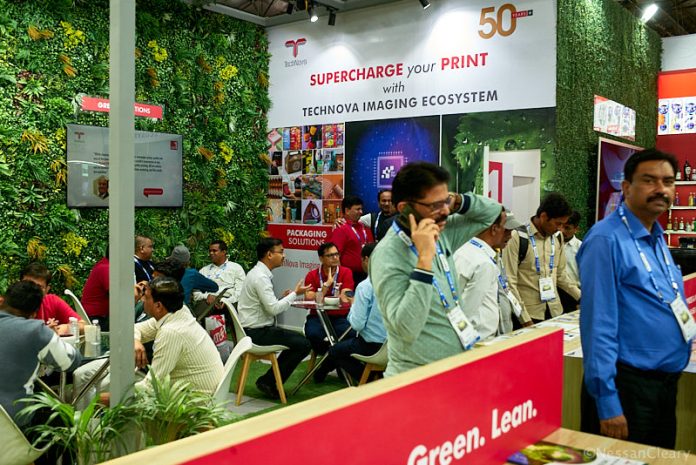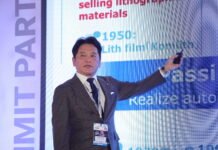This is the second part of my report from the Pamex show in Mumbai, India. There’s something reassuringly familiar about the different print fairs regardless of which part of the world they are in, and this was just as true of Pamex as any other show, with the added bonus that everyone speaks good English!
The other advantage of Pamex is that beyond the cool of the halls, there is the heat of Mumbai, a welcome relief from the British winter. At first glance, Mumbai appears chaotic, especially on the roads with the cars and taxis, the three-wheelers, motorbikes, pushbikes and hand carts, plus people walking through the traffic, not to mention the stray dogs and even the occasional cow, all competing for space. But somehow there is enough room for everyone so that the chaos gives way to the realization that India simply operates on a different rhythm to the West, though weaving through the traffic on a three-wheeler is not for the faint-hearted.
Nonetheless, this is what it looks like when 1.4 billion people all drag themselves out of their past and forge a modern developed nation. India may have high levels of poverty but it also has a proven space industry, a well-defined IT sector and a highly literate workforce. In some respects, it’s a lot like Europe, in that the farmers were marching on the capital, there’s a Starbucks on every corner and the most popular food is…pizza. Oh, and the England cricket team was busy losing the second test match in the midst of Pamex so even the sports news from home was reassuringly familiar.
The show appeared reasonably busy on the first day, with a noticeable surge in visitor numbers on day two and it was even busier by the third day. There was a definite sense of people turning up to do business.

Edale
Surprisingly, the British label press manufacturer Edale, which Canon acquired last year, also exhibited, albeit on a separate stand from Canon, and even in a different hall. Even more surprisingly, the stand was manned by a team from the UK, the only European label press manufacturer to take the Indian market seriously enough to turn up in force. Sales director Darren Pickford explained, “India is a growth market. It’s a very vibrant market, very entrepreneurial.”
It’s not obvious why Canon bought Edale, which appears to be more opportunistic than strategic. Canon’s LS4000 label press is heavily based around the old FFEI Graphium label press, which was itself built around a chassis from Edale. Pickford says that Edale helped Canon when it was readying the LS4000 and that the two companies got to know each other then. He adds, “The owner wanted to retire so it seemed like a good fit.” It could equally be that Canon simply didn’t want a rival snapping up Edale and complicating any further development of the LS4000 platform.
Either way, Canon did not use Edale’s expertise when developing its latest label press, the LS2000, despite the fact that transport systems for label stocks can be quite tricky because of the need to account for the correct tension throughout for a wide range of different substrates. Pickford says that Edale is still a separate company with its own profit and loss accounting, reporting to Canon Production Printing (which used to be Oce) though he adds, “We are beginning to see a little bit of new branding.”
Gurjit Singh Dhingra, assistant director for marketing and sales for Canon India, told me that Canon is content for Edale to concentrate on selling to conventional label customers, “The idea is that they will develop the market share and then Canon will be able to sell more digital.”
Pickford elaborates, “They wanted us to grow and are giving us the funding to grow so it’s interesting for us.” He says that the company’s current turnover is around £26 million, noting, “We have a plan to double in the next five years. We have already doubled in the past four years.”
Pickford says that Edale is seeing a huge shift in its business, noting that three years ago the main part of the business was on labels but that now 70% of its work is on cartons. He adds, “Labels is a tough market but the cartons industry is growing. We are trying to break into the carton market with our flexo press.”
The FL5-Carton is a 670mm wide press that can take cartons up to 700 microns thick, and can also be used to run label stocks. Pickford explains, “It’s fairly unique because it has a flatbed die-cutter in line for single pass. The print is continuous, the die cutter is intermittent, so we have a buffer underneath. The web still moves at 80-90 meters per minute.”
He says that the machine allows converters to run a lot of features in a single pass – “so there’s no work in progress which makes it very cost-effective.” It can be configured with a range of converting options, including cast and cure, laminating, spot varnish, embossing plus print and reverse print. The embossing is on the die-cutting unit so that users can emboss and die-cut in a single pass. Most users opt for 8 or 10-color units.
Pickford notes, “It’s fairly modular and there’s very little mechanical connection between the units, it’s all electronic. There are seven servo motors on every print station so it’s highly automated and highly repeatable. Every time we run a job we record the settings so it can repeat that exactly again. You can have 100% automation. And, we are getting quality very close to offset.” The set-up uses around 35 square meters of substrates, taking around 15 minutes to change from one job to the next.
He says that there are four FL5-Cs currently installed in India and estimates that there could be another 30-40 label presses, noting that it’s difficult to get accurate figures as some have been brought to India as second-hand machines from other countries. He says that India is an interesting country to work in because the customers are always trying to do things a little differently, adding, “The customers we have here in India want the highest quality.”
He says that some customers do run extended color gamut ink sets but that it makes very little difference in the time to changeover between jobs because it only takes up to two minutes to change each color.
UV Graphic Technologies
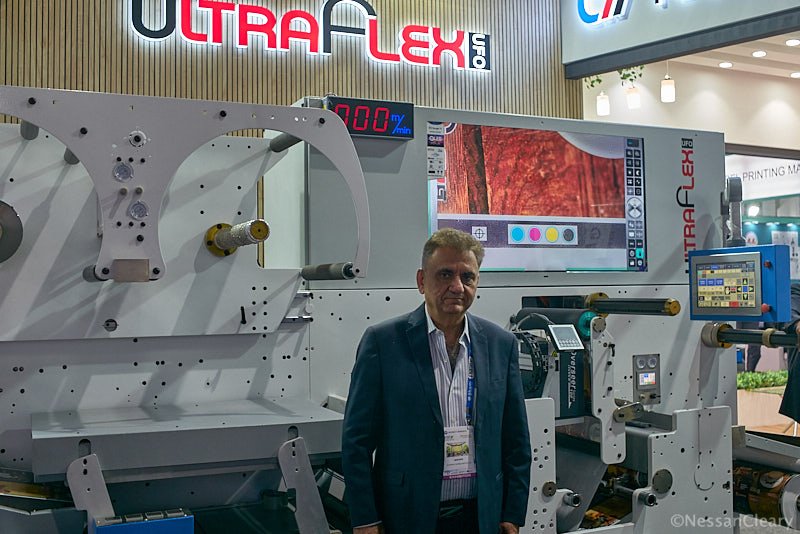
UV Graphic, which is based in Noida across the river from New Delhi in the National Capital Region, showed off its UltraFlex press with a 450 mm wide flexo label press right at the entrance to Hall 1. This press can handle both film and pressure-sensitive label stocks and the company also makes a wider 670mm version though that’s only designed for film. UVG also has a division that makes LED units so has developed its own LED curing modules for the press. However, customers can change these modules over to conventional UV lamps within a matter of minutes, which is handy for those inks that require conventional curing. It can have 10-colors plus delam/ relam, peel and seal, and turn bar – and be run at 150 meters a minute.
The main advantage of this press is its very fast makeready, helped by the automatic registration system. Abhay Datta, director of UV Graphic, demonstrated this for me. There’s a reference point on the edge of each print cylinder and two cameras positioned at either end of the print cylinder to check this reference and the registration marks. Each unit has its own controller so the operator can adjust each one separately and just has to press a button; the cylinders then move automatically into position as the cameras find the registration and reference marks. The system monitors the print as the press runs and tightens the registration up, compensating for any stretching in the substrate.
Datta says that the majority of these presses are installed in India but there are also two in Arizona in the US, one in Italy and another in South Africa.
Vinsak
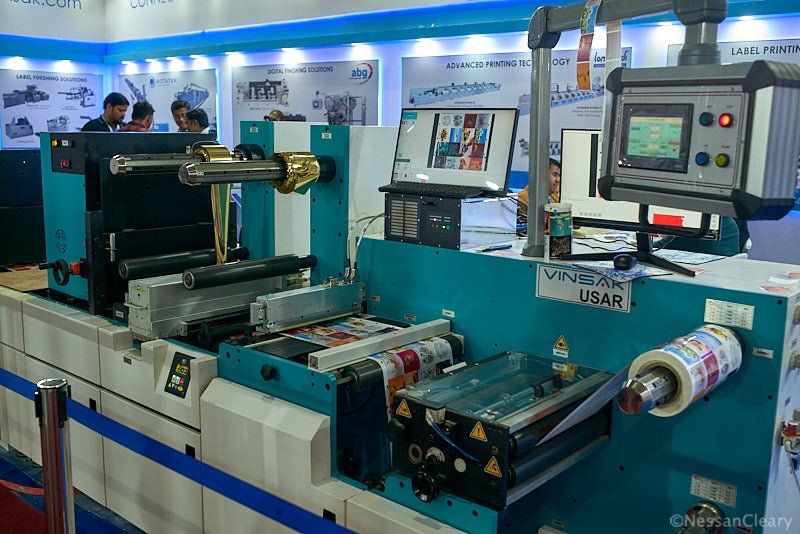
I also came across Vinsak, which is headquartered in Gurgaon in Haryana just south of Delhi and also in the National Capital Region. India. This company distributes a range of narrow web labelling equipment from Lombardi, Iwasaki, Rotatec and AB Graphics, with sales in Africa and the Middle East as well as India.
Vinsak also makes its finishing machine, the Universal slitter and rewinder, which has a 430mm working width and is a version of an ABG design produced under license. Vinsak has added several useful modules, including a QR barcode unit with Kyocera KJ4B printheads, which was shown printing invisible UV inks for security applications, and a digital varnishing unit that uses Xaar printheads. There’s a Clear Lake vision system that checks the finished print against a reference sample for any defects. It also has a foiling unit and it’s possible to add other units such as a flexo station.
Arrow and Mehta Hitech
Elsewhere, Arrow showed off its Aqua 350R label printer, which is based on the Memjet DuraFlex printhead and gives a cost-effective labelling option that’s capable of printing resolutions up to 1600 dpi. Arrow also had an EFI Pro 30H hybrid wide format press on its stand.
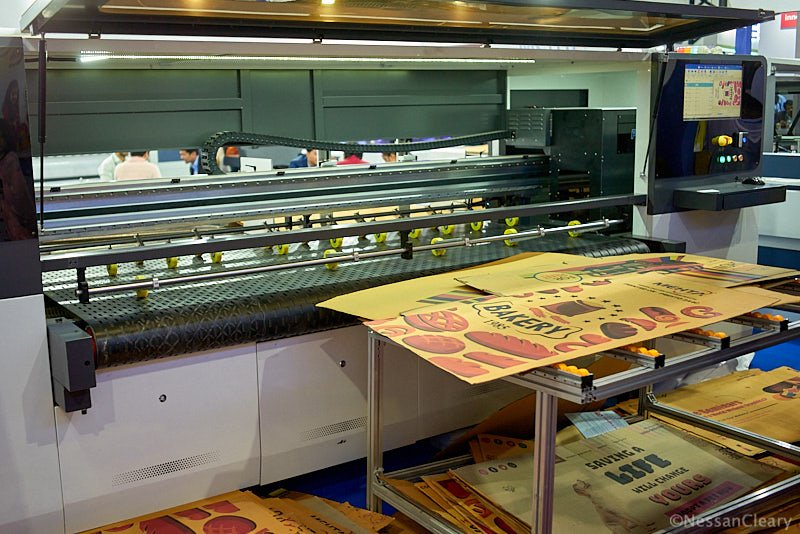
Mehta Hitech Industries, which was formerly called Mehta CadCam, brought along a number of new printers, including a large format machine for printing to corrugated boards that’s made in India. The Presto PRAI 2616 has a CMYK ink set with water-based inks and uses thermal printheads, with a choice between eight and 16 heads. It can produce up to 700 square meters an hour.
Line-O-Matic moves into packaging
Leaving aside the labelling market, Line-O-Matic built its reputation on developing presses for printing stationery, such as ruled notebooks. The company also makes converting machines and has recently moved into printing and packaging.
Nirav Parikh, chief general manager for Line-O-Matic, says, “We felt that we had the capability and could do more than what we are doing at the moment. We had good resources, good capability and manpower. The world is moving towards packaging so we wanted to go to this market.”
Referring to the economy and the stationery industry, he adds, “Before the pandemic, the situation was pretty good and now we are back to that.” The company will have the largest stand amongst the Indian vendors at the Drupa show, with four presses or machines, one from each division.
Technova
Technova, which sells a broad range of machines and consumables for printing and packaging, chose to highlight its Green Solutions approach with its chemistry-free violet plates, VioGreen, as well as the Kratos processless thermal plates, and Sakata INX UV flexo inks.
Deepak Chawla, senior general manager for Technova, says there is a decline in commercial conventional printing but that packaging and label printing are both growing, adding, “But we will be moving towards digital.”
Technova also discussed Esko’s CtP imagers and Chawla says that the company is also working with Eco3, the company that bought Agfa’s prepress business. There was a link to a live demonstration of an HP Indigo 6K for labels and packaging. Technova also sells Konica Minolta production printers paired with Duplo finishing devices.
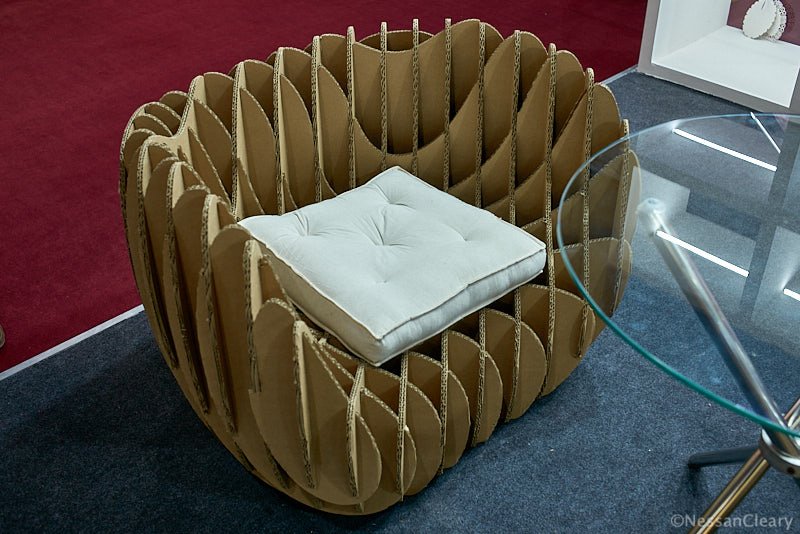
Digital cutting tables
Right on the corner of the Technova stand I came across a digital cutting table from the Chinese manufacturer Jwei that seemed to attract a lot of attention. Elsewhere, Zund showed off one of its S3 digital cutting tables, while Emerging Graphics displayed an iEcho cutting table. Kongsberg demonstrated an X20 cutting table and a range of cutting tools, as well as a number of chairs cut out of cardboard that were surprisingly comfortable to sit on!
Stay tuned for the final part of this series of reports from Pamex, where I’ll cover some of the packaging solutions on show. In the meantime, you can find the first part of this story here.
First published on 26th February 2024 in the Printing and Manufacturing Journal. Reprinted by permission. www.nessancleary.co.uk



